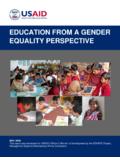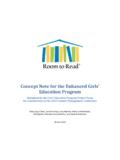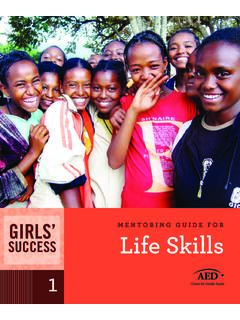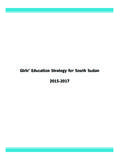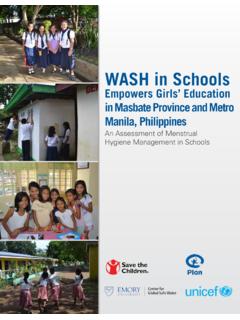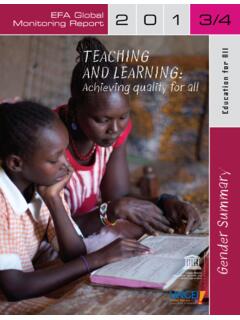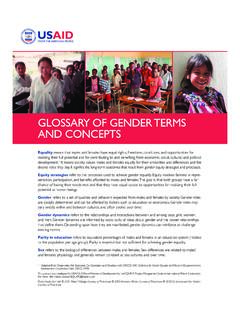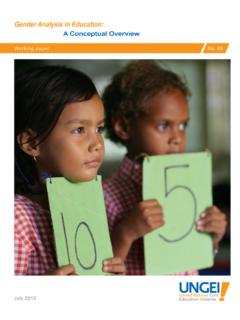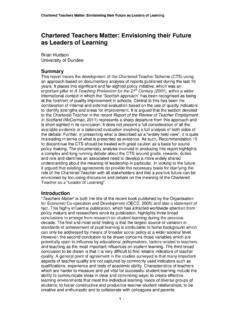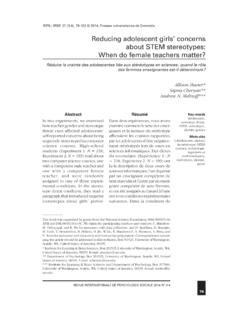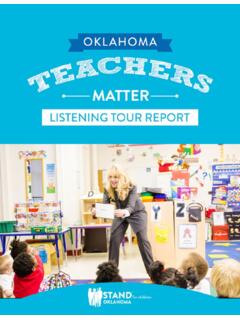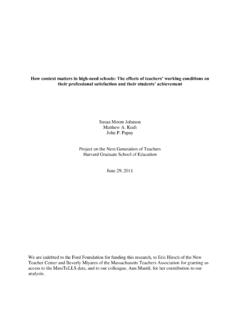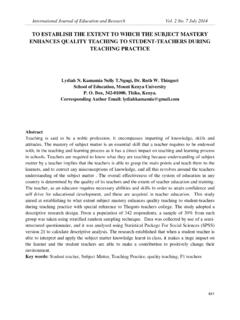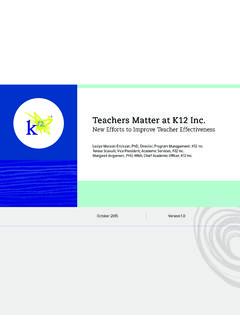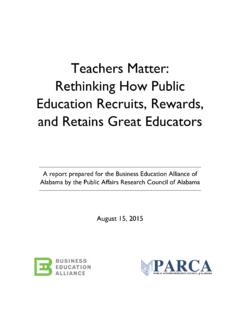Transcription of Why Women Teachers Matter in Secondary Education
1 SPECIAL ARTICLEAUGUST 8, 2015 vol l no 32 EPW Economic & Political Weekly48 Why Women Teachers Matter in Secondary EducationKameshwari Jandhyala, Vimala RamachandranThis article is based on a research study done by Educational Resource Unit in 2013 14 and supported by MacArthur Foundation that examined the importance of Women Teachers at the Secondary school level, with a special focus on Rajasthan. The authors would like to acknowledge the comments of an anonymous Jandhyala is with ERU Consultants, Delhi; Vimala Ramachandran is with the National University for Educational Planning and Administration, New have been plenty of policy recommendations and interventions to increase the pool of Women Teachers in India, especially at the school level. Despite this, research in three districts of Rajasthan shows that any such attempt would need an integrated and organic approach that builds bridges across the Secondary , collegiate, and teacher -training levels.
2 The paper points out that what is needed is a def inite break from past practice to creatively re-conceptualise the Education continuum, while putting forward some recommendations to lower barriers in the way of Secondary Education for girls in the has been no dearth of policy recommendations or specifi c interventions to advance and increase the pool of Women Teachers , especially at the school level. No doubt, this concern has always been entwined with the larger national goals and discourse on development of modern edu-cation in India, a signifi cant part of which involves promoting Education among Women and girls. A focus and thrust on Women Teachers is not recent; it has been central to much of the educational discourse from the 19th century. In a tradi-tional society such as India where barriers to educating girls in the public domain were circumscribed by caste and religious restrictions, it was not surprising that spaces for training wom-en as Teachers opened up fairly early on.
3 Successive fi ve year plans and commissions made recommendations on the issue of female Education and the need to create conditions conducive to increasing the numbers of Women The signifi -cance of Women Teachers was also foregrounded in efforts to universalise primary and subsequently elementary Education from the early 1990s. As a result, many state governments introduced reservations, in some cases up to 50%, for Women in teacher recruitment these measures, in Rajasthan the percent-age of Women Teachers is far below the national average and it varies from district to district. At the Secondary level, the per-centage of Women Teachers across the state is 19% (UDISE 2011 12). The percentage of Women Teachers dips to below 9% in educationally backward districts and those that are sparsely populated such as Jaisalmer, Jalore, and Barmer; while it is more than 40% in Kota, Sri Ganganagar, and Bikaner dis-tricts where Education of Women has been fairly good for more than fi ve decades now.
4 Low participation of Women in second-ary and higher Education leads to shortage of Women Teachers in Secondary schools. Acute shortage of Women Teachers in Secondary schools works as a barrier to girls participation in areas where traditional practices continue and where Women s safety is a real problem. The situation does not only vary across districts, but also among different social groups, lead-ing to stark differences among different article, based on qualitative research in three districts of Rajasthan, explores the cumulative impact of the spiral of fewer Women Teachers and low enrolment of girls in school. The criteria for selection of the fi eld sample were districts with a high concentration of Scheduled Castes (SC), Scheduled Tribes (ST) and Muslims in the population; urban and rural rep-resentation; and the presence of teacher -training institutions SPECIAL ARTICLEE conomic & Political Weekly EPW AUGUST 8, 2015 vol l no 3249and Women Teachers at the Secondary level, higher than the state average, closer to the state average, and lower than the state average.
5 Accordingly, the three sample districts selected were Baran (poor, high ST population); Barmer (geographical and developmental disadvantage and high SC population), and Ajmer (high urban Muslim population). In each district, two blocks were selected, one closer to the district headquarters and another in a remote location. The research study covered six blocks across three districts, six Secondary /higher second-ary schools (four for only girls), six government and private undergraduate colleges (three for only girls), and six govern-ment and private BEd colleges (one for only girls). The research tools and methodology included a review of the Secondary literature and data, as well as a set of tools for conducting in-depth interviews and focus group discussions (FGD). In-depth interviews were held with state- and district-level Education department offi cials, and principals of the sample BEd and undergraduate colleges and with head teach-ers of the sample Secondary and higher Secondary schools.
6 Semi-structured inter views were held with Teachers at the col-legiate and school levels. Focus group discussions were held with girl students in the sample BEd and undergraduate col-leges and in the sample Secondary and higher Secondary schools; and at the community level, with parents of girls who dropped out at the Secondary gross enrolment ratios (GER) along the educational con-tinuum, nationally and in Rajasthan, highlight both gender and social gaps quite clearly. Table 1 shows that in Rajasthan, as we move from primary (classes 1 5) to higher Education , the gender and social gap and dropout rates at each successive level become more signifi cant. As it shows, while the GER at the upper primary and Secondary levels indicate a signifi cant drop, there is sharper drop in GER for girls at the higher Education level The lowest higher Education GER is for SC girls at , followed by ST girls at This is not surprising because the share of student enrolment in higher Education across all marginalised groups in Rajasthan is less than their proportionate share in the population, which is indicative of the continued persistence of educational backwardness among these communities.
7 The situation in the sample districts, for instance, presents a similar picture where the gaps in transition to the next higher level of Education become sharper. This is true for girls in gen-eral, particularly across marginalised social groups like SCs and STs. In Barmer District, in 2012 13, the total enrolment of girls at the Secondary and higher Secondary levels was and The situation of girls from marginalised Table 1: Gross Enrolment Ratio in Rajasthan, 2010 112010 11 All Scheduled Castes Scheduled Tribes Boys Girls Total Boys Girls Total Boys Girls TotalClasses 1 5 124 132 Classes 6 8 91 73 9 10 11 12 36 Education 18 24 years (2011 12) 13 Source: SES GOI 2010 11.
8 Higher Education data from All India Survey of Higher Education , 2013. communities is a Matter of grave concern with enrolment of SC and ST girls at and at the Secondary level, and 11% and at the higher Secondary Disparities are refl ected not only in enrolment but also at the faculty and staff levels. In Rajasthan, compared to men, Women are considerably under-represented among faculty and staff in both Secondary and at higher Education institutions and this defi cit is higher for all marginalised social groups. The reduced number of Women as one goes up the Education ladder is not surprisingly refl ected in the number of Women Teachers available at the Secondary level, and this remains an important concern in Rajasthan. Overall, the number of wom-en Teachers at the Secondary level has increased at a very slow pace.
9 In 1990 91, the percentage of Women Teachers at the sec-ondary and higher Secondary levels (all managements) was 22% and 25% respectively. In 2011 12, this improved margin-ally to and As Table 2 shows, the rural urban divide is sharp. In the sample districts, except for Ajmer, which has a signifi cantly higher percentage or proportion of Women Teachers , the situation in backward districts such as Barmer and Baran is poor. The higher percentages of Women Teachers at the higher Secondary level are also because these schools are generally located in urban and semi-urban areas where road connectivity and transport are not a problem. Further, the higher presence of Women Teachers in Ajmer District can be explained by that access to higher Education is much better there. Ajmer is one of the seven districts in Rajasthan with a high concentration of higher Education It has 18 BEd colleges against three in Baran and four in between social classes, as much as between genders, stand out when gender is intersected with social category.
10 In Rajasthan, at the Secondary school level, only are SC and are ST Women Teachers , and at the higher Secondary level, only and are SC and ST Women Teachers respectively. It may be pertinent to point out that the low representation of SC and ST Women Teachers is mirrored in the case of SC and ST men as well. The reasons for this defi cit in the representation of marginalised communities, which is further exacerbated in the case of Women , are not hard to see. Basant and Sen (2010: 69) make a strong argument for locating the issues of Secondary Education in the ambit of any strategy looking to enhance participation in higher Education . They argue, Once persons from underprivileged groups cross the school threshold, the chances of their going to colleges are quite high.
